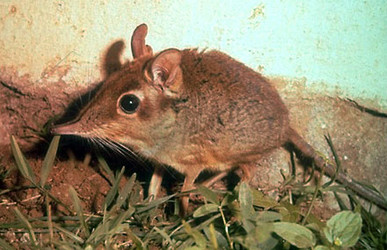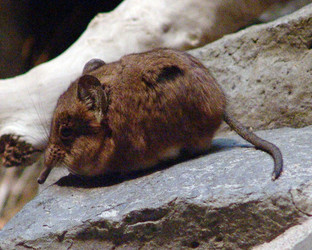Macroscelidea
Macroscelididae
Elephant shrews, Sengis



This tree diagram shows the relationships between several groups of organisms.
The root of the current tree connects the organisms featured in this tree to their containing group and the rest of the Tree of Life. The basal branching point in the tree represents the ancestor of the other groups in the tree. This ancestor diversified over time into several descendent subgroups, which are represented as internal nodes and terminal taxa to the right.

You can click on the root to travel down the Tree of Life all the way to the root of all Life, and you can click on the names of descendent subgroups to travel up the Tree of Life all the way to individual species.
For more information on ToL tree formatting, please see Interpreting the Tree or Classification. To learn more about phylogenetic trees, please visit our Phylogenetic Biology pages.
close boxReferences
Butler, P. M. 1995. Fossil Macroscelidea. Mammal Review 25:3-14.
Corbet, G. B. 1995. A cladistic look at classification within the subfamily Macroscelidinae based upon morphology. Mammal Review 25:15-17.
Corbet, G. B. and J. Hanks. 1968. A revision of the elephant shrews, family Macroscelididae. Bulletin of the British Museum (Natural History) Zoology 16:1-111.
Douady, C. J., F. Catzeflis, J. Raman, M. S. Springer, and M. J. Stanhope. 2003. The Sahara as a vicariant agent, and the role of Miocene climatic events, in the diversification of the mammalian order Macroscelidea (elephant shrews). Proceedings of the National Academy of Sciences (USA) 100:8325-8330.
Hartenberger, J.-L. 1986. Hypothèse paléontologique sur l'origine des Macroscelidea (Mammalia). Comptes Rendus de l'Academie des Sciences Serie II 302:247-249.
Kratzing, J. E. and P. F. Woodall. 1988. The rostral nasal anatomy of two elephant shrews. Journal of Anatomy 157: 135-143.
Leirs, H., R. Verhagen, W. Verhagen and M. R. Perrin. 1995. The Biology of Elephantulus brachyrhynchus. Mammal Review 25:45-49.
Madsen, O., P. M. T. Deen, G. Pesole, C. Saccone, and W. W. deJong. 1997. Molecular evolution of mammalian aquaporin-2: Further evidence that elephant shrew and aardvark join the paenungulate clade. Molecular Biology and Evolution 14:363-371.
Matson, J. O., and B. R. Blood. 1998. Morphological variability and species limits in elephant shrews (Elephantulus intufi and E. rupestris) from Namibia. Mammalia 62:77-93.
McKenna, M. C. and S. K. Bell. 1997. Classification of Mammals Above the Species Level. Columbia University Press, New York.
Neal, B. R. 1995. The ecology and reproduction of the Short-snouted Elephant-Shrew, Elephantulus brachyrhynchus, in Zimbabwe with a review of the reproductive ecology of the genus Elephantulus. Mammal Review 25:51-60.
Nicoll, M. E. and G. B. Rathbun. 1990. African Insectivora and Elephant-Shrews, an Action Plan for their Conservation. International Union for Conservation of Nature and Natural Resources (IUCN), Gland, Switzerland.
Nowak, R. M. 1999. Order Macroscelidea. Pages 1739-1745 in: Walker's Mammals of the World. Sixth Edition. Volume II. (R. M. Nowak). Johns Hopkins University Press, Baltimore.
Patterson, B. 1965. The fossil elephant-shrews (Family Macroscelididae). Bulletin of the Museum of Comparative Zoology, Harvard 133:295-335.
Perrin, M. R. (ed.) 1995. The Biology of Elephant-shrews - A Symposium Held During the 6th International Theriological Congress, Sydney, 5 July 1993. Mammal Review 25:1-100.
Perrin, M. R. 1995. Comparative aspects of the metabolism and thermal biology of elephant-shrews (Macroscelidea). Mammal Review 25:61-78.
Raman, J. and M. R. Perrin. 1997. Allozyme and isozyme variation in seven southern African elephant-shrew species. Zeitschrift für Säugetierkunde 62:108-116.
Rathbun, G. B. 1995. Conservation issues and strategies for elephant-shrews. Mammal Review 25:79-86.
Rathbun, G. B. and P. F. Woodall. 2002. A bibliography of elephant-shrews or sengis (Macroscelidea). Mammal Review
Volume 32(1):66-70.
Simons, E. L., P. A. Holroyd, and T. M. Bown. 1991. Early Tertiary elephant-shrews from Egypt and the origin of the Macroscelidea. Proceedings of the National Academy of Sciences (USA) 88:9734-9737.
Tabuce, R., B. Coiffait, P. E. Coiffait, M. Mahboubi, and J. J. Jaeger. 2001. A new genus of Macroscelidea (Mammalia) from the Eocene of Algeria: A possible origin for elephant-shrews. Journal of Vertebrate Paleontology 21:535-546.
Tolliver, D. K., L. W. Robbins, I. L. Rautenbach, D. A. Schlitter, and C. G. Coetzee. 1989. Biochemical systematics of elephant shrews from southern Africa. Biochemical Systematics and Ecology 17:345-355.
Wenhold, B. A. and T. J. Robinson. 1987. Comparative karyology of 3 species of elephant-shrew (Insectivora, Macroscelididae). Zeitschrift für Säugetierkunde 52:1-9.
Wilson D. E. and D. M. Reeder. 1993. Mammal Species of the World: A Taxonomic and Geographic Reference. Second edition. Smithsonian Institution Press, Washington D. C.
Woodall, P. F. 1991. An ultrastructural study of the spermatozoa of elephant shrews (Mammalia, Macroscelidea) and its phylogenetic implications. Journal of Submicroscopic Cytology and Pathology 23:47-58.
Woodall, P. F. 1995. The penis of elephant shrews (Mammalia, Macroscelididae). Journal of Zoology 237:399-410.
Woodall, P. F. 1995. The male reproductive-system and the phylogeny of elephant-shrews (Macroscelidea). Mammal Review 25:87-93.
Woodall, P. F. and C. Fitzgibbon. 1995. Ultrastructure of spermatozoa of the yellow-rumped elephant shrew Rhynchocyon chrysopygus (Mammalia, Macroscelidea) and the phylogeny of elephant shrews. Acta Zoologica 76:19-23.
Information on the Internet
- Elephant Shrews. California Academy of Sciences.
- Golden-rumped elephant-shrew (Rhynchocyon chrysopygus). ARKive.org. Check out the movies!
- Order Macroscelidea. Animal Diversity Web. University of Michigan Museum of Zoology.
- Afrotheria Specialist Group. IUCN - The World Conservation Union. Species Survival Commission.
- Elephant Shrews. A page by Peter Woodall, an elephant shrew researcher at the University of Queensland, Brisbane, Australia.
Title Illustrations

| Scientific Name | Elephantulus |
|---|---|
| Location | Nairobi (Kenya) |
| Creator | Lloyd Glenn Ingles |
| Specimen Condition | Live Specimen |
| Source Collection | CalPhotos |
| Copyright |
© 2001 California Academy of Sciences

|
| Scientific Name | Macroscelides proboscideus |
|---|---|
| Location | Grzimekhaus in Frankfurt Zoo |
| Specimen Condition | Live Specimen |
| Source | Kurzohrrüsselspringer |
| Source Collection | Flickr |
| Image Use |
 This media file is licensed under the Creative Commons Attribution-NonCommercial-ShareAlike License - Version 2.0. This media file is licensed under the Creative Commons Attribution-NonCommercial-ShareAlike License - Version 2.0.
|
| Copyright | © 2006 Joachim S. Müller |
About This Page
Page copyright © 2000
All Rights Reserved.
Citing this page:
Tree of Life Web Project. 2000. Macroscelidea. Macroscelididae. Elephant shrews, Sengis. Version 01 January 2000 (temporary). http://tolweb.org/Macroscelididae/15960/2000.01.01 in The Tree of Life Web Project, http://tolweb.org/









 Go to quick links
Go to quick search
Go to navigation for this section of the ToL site
Go to detailed links for the ToL site
Go to quick links
Go to quick search
Go to navigation for this section of the ToL site
Go to detailed links for the ToL site